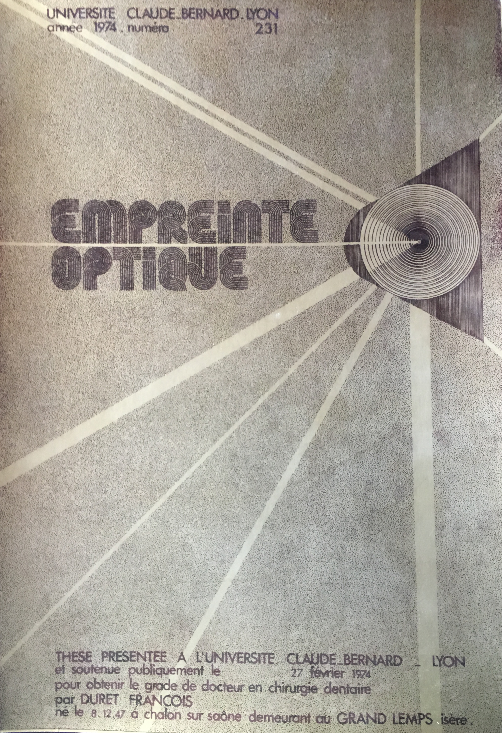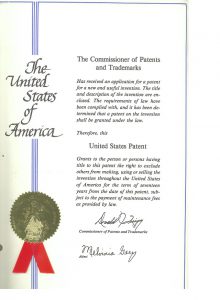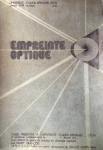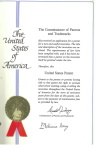1973 Thesis and Inventions
Thoughts and inventions
Every year after 1998, the Ecole des Mines d’Alès had become accustomed to bringing together some fifty creative enthusiasts around its students. We found large-scale industrial institutions such as Renault, National train’s SNCF, Carrefour, Décathlon and Legrand, but also managers of small Startups with new ideas in their heads. Among them was an exception, a «alone inventor» also called «free electron». This role was curiously attributed to me from the creation of these exciting seminars and it was only my age that made me leave it.
This exciting experience allowed me to discover that there were two creative worlds, that of thinkers/researchers and that of artists/inventors. The former follow strict reasoning almost mathematical management of creativity (MRT …) while the other imprints of the paths free from any constraint. These worlds often lead to innovation for the former and invention for the latter.
I also slowly came to think, at the risk of shocking, that if creativity can be guided, the invention remains intuitive and solitary and that inventing has no rule, it appears to me today simply as a gift offered by nature as there is that of painting, music or sport.
Among all the creative people at the Ecole des Mines we may have had the same muse, but it seemed to me that she only spoke to the inventors. I fundamentally feel (and joy) to be part of the world of these intuitives, because all my inventions (see among others the pages Patents and Soleau letters) came to my mind «like this, without reason».
The invention is in my life what the drawing is to the painter, the orchestra to the musician and the verses to the poet ….
But careful invention and inventing are two different things. To invent is not only to imagine something new, because it is only the first step (specific to the inventor and his muse). To invent is also to develop one’s invention and, if possible, to put it on the market to prove its usefulness and to make everyone share the comfort it can bring. The inventor therefore has a dual role, that of designing then doing and/or guiding… Inventing is therefore a fast and solitary act in itself followed by a very long and complex work often carried out in a team. If no invention can exist without inventor, it is the whole of the creative idea and its eventual implementation as a team that represents to me the work of the inventor in all its essence.
… But can you imagine a musician who just scribbles a few lines of musical staves without ever playing them?
On the other hand, make no mistake, a team never replaces the initial creative idea. The invention thieves, who are very numerous, know this: they run out of ideas very quickly and do not feel the evolution of new concepts. This is fortunate, because these are only counterfeiters who are finally trying to sign a painting made by another.
The invention of CFAO and a few others …
It all started abruptly …
1) Even though I imagined a lot from a very young age, it really started in December 1970, when I was both a student at the Faculty of Science (Bachelor of Science) and at the Faculty of Dentistry (3rd year). This double membership, which my Dean Robert Vincent had accepted, allowed me to reconcile two techniques having the same purpose, but using very different means: dental prints (dental school) and dimensional metrology in 3/4D measurements of any object (Faculty of Science) within the framework of the theoretical foundations of the Thermodynamics of classical and quantum systems.
After having validated this invention with my two uncles, one computer scientist and the other dentist, who was going to be the irreplaceable companion of all my future adventures (thank you Bernard!), I had the chance to work in the Jura, in «la Pesse» During the summer of 1971, he met a young and brilliant physicist, Jean Michel Decaudin, at the Hotel Burdet. Together with Prof. Bernard from INSA, he was going to confirm the validity of my theory of «the Optical Dental Impression» and «the CadCam/Artificial Dental Intelligence» and help me to understand the principles of metrology 3/4D, computer science and digital machining (see document 1). My first attempts at the Ruby Laser in 1969 were to help me understand holography.
A large documentation (see the 308 references of the thesis) collected with the support of Prof. Perez and especially Prof. Jacques Dumas (see document 2) followed by a first editing in the summer of 1972 led me to proceed with a first drafting presented for correction at the end of 1972, two years after the statement of the initial idea. In fact, I filed an application with ANVAR in November 1972 (see document 3).
My thesis supervisor, Prof. J. Dumas, who has since become my friend, carried out a meticulous rehabilitation and returned my work to me 3 months later in March 1973 (voir document 4). The work of revision was important, but as it came at the same time as my examinations, it was not until June 1973 that I submitted the complete work for a new correction, but this time to all the members of the jury (see document 5). After control of these Professors, the text was transmitted on 6 November 1973 (see document 6) to the headquarters of the Academy of Lyon for its final approval and the authorization for public presentation. It took place on 27 February 1974 in the thesis room of the dental school in Lyon (see document 7).
You will find the full text in French (voir document 8 -en français) and in English (voir document 9 -in english) so that you can freely copy the passages that interest you.
- – The French DDS text (Fr) being the PDF copy of the exact text given to the proofreaders in June 1973, it remains very «primary» with its French mistakes and its drawings made by show of hands, but it seemed to me more honest to present it to you «as is» as given to the members of the jury, even if it may displease the purists.
- – The English DDS text (UK) has been translated several times, but it is the last translation, made in 2009 by Alix Brunel that I retained, because it seemed to me the most consistent with the original text. I thank her for the work that took her almost a year in addition to her daily work and forced her to endure a particularly hard-nosed examiner.
For those who do not have the courage to read these 300 pages, I have made a summary of 25 pages, more digestible (I hope !!) where I return to the most important points of each chapter and/or I tell the «little story» that surrounded this work (see document 10). In particular I quote in red the current systems so that you can find the correlation between my 22/24-year-old view of the CFAO in 1973 and the current state of technology. All the systems on the market seem to me to have been described as early as 1973.
… To grow and diversify slowly
2) As early as 1975, my work was already referred to in some works as we can see in the DDS thesis of a student who will become a professor, known and renowned head of department, Professor Margerit (see document 11).
3) In 1976 I present this work and my evolutions made between 1973 and 1976 (in particular my double view lingual and vestibular which will be applied in my IOS of 1983) in congress in Tours thanks to the courtesy of Prof. Joseph Thouvenot Academician (see document 12– en français and in English). I must admit without false modesty that this presentation has attracted the attention of some great researchers, including the Nobel Prize winner A. Kastler who encouraged me in this direction. It was, I must admit, one of my great pride at the time.
4) During this period, from 1976 to 1979, I carried out a lot of theoretical research and the first experimental tests in the laboratories of Lyon (Pr Dumas) and Tours (Pr Thouvenot) by cellular LASER scans, point’s modeling and macroscopic machining as evidenced by my request for University Assistantship in 1976 (validated).
5) In 1979, joined and supported by one of my students, Christian Termoz, then and especially with the help of my wife, my uncle Bernard and the entire Lyon team of the Hennson company (thank you Jean Pierre Hennequin), my work took a much more “industrial and clinical”. Between 1980 and 1992 there were 7 patents ans Soleau letters (see patents on the CFAO) and numerous publications, conferences (voir conferences et Publications) and articles in national and international press (see press articles).
This period of 13 years (1979-1993), capital in the history of digital dentistry, was first marked by the passage of the final technical specifications of the invention (1979) to the manufacture of the first functional prototypes (1980 to 1985) then (between 1986 and 1987) the introduction of the world’s first true CFAO system for dentists and prosthetists, the Duret*- system (Hennson Society). It will end in 1993 with the Sopha Bioconcept Company and its clumsy copy of the Hennson system, the «Sopha Cadcam».
« Duret System = Dental Unit for Resored Esthetic Teeth »
6) This important period was also marked by several of my inventions which are still exploited today industrially. I mean the XR.VG (patent 1983), virtual and digital articulators (Acces Articulator/1984), heterogeneous composites oriented and architectured (Aristée 1986) as a tooth, the first teeth in Zircon (with the company CEA/Desmasquet.1985), a dental spectrocolorimeter (with Bertin SA. 1987) and especially the first carbon fibre and then glass fibre posts (Composipost with my uncle and RTD. 1989).
7) Although the theoretical, fundamental and clinical part of my work continued very actively after 1993, (as a Professor and University Chairman, in the USA at the University Southern – California – USC from 1989 to 1998 and then visiting in Japan at the Nipponne Dental University – NDU- from 1999 to 2003), it must be admitted that I experienced a great period of “loneliness” after the disappearance of Hennson and his 50 engineers.
8) The revival of my activity as an inventor (injured) was gradually made thanks to the company GC and 3 friends, Akira Kikuchi of GC (and its remarkable President), A Siradj and my friend of always Jean Claude Haas (ex Matra-Hennson). This convalescence was first occupied by a work of expertise with GC which led to the realization of the first Japanese CadCam system (and my third CadCam system) known as GN1 and developed jointly with GC (prime contractor) Hitachi and Nikon then led the first steps in the development of the Canadian Pro50 system with Nobel Int. Medical Cares (later Cynovad, then … Dental Wings).
9) It was during this work of expertise, and with a great thirst for creative freedom, that I embarked on a new path, that of polymerization. It led me, when I created my own company in 1993, to invent the “fast polymerization” of dental composites that took the clinician’s mouth work from 1:30 to 5 seconds (in the patient’s interest). Thus were born in my laboratory the first plasma lamps (Apollo in 1997) and then LED (Mini LED in 1999) sold more than 150,000 copies. It was also during this development that I came up with the invention of the «chromophoresis» as my friend F. Diéras say (2002), the first active whitening technique for teeth unfortunately stuck to the ground by a jealous dentist, advice at Acteon (not the first, not the last !).
10) Totally healed, the year 2008 saw me reconsacrer 100% to my first loves, the dental CadCam and more exactly the « Optical Print/impression ». All systems only replicating my first invention: the Intra-oral Scanners (IOS) using the expensive and complex projection of structured light (Hennson), in 2009 the invention «Condor» The first 2nd generation IOS no longer using structured light was born. It was developed with V., O. Querbes and G. de Vreese between Narbonne and Toulouse. With this new invention I was finally able to achieve a dream of youth, a true clinical revolution, thanks to A. Duret-Fournier and his company Invi’sart: the first door optical footprint (IOT) capable of taking an optical 3D/4D shot of a whole mouth in a few seconds. The circle of page 241 of my 1973 thesis was complete.
11) It must be said that in the meantime I had also relaunched in 2013 the development of a new digital clinical practice framed by augmented reality and artificial intelligence in which the door imprint Optics of Invis’art is the centerpiece. The invention has been exhibited in two patents (2014 and 2015) and is about to reach its first trials …. Isn’t dental CadCam the first artificial intelligence system described and developed in medicine? … But that’s another story.
Important “firsts” in my life as an inventor
12) For almost 52 years (1970-2022), I also achieved a number of world premieres in digital dentistry research and teaching.
In addition to being the inventor (with Artificial Intelligence and Medical Expert Systems – 1973), I developed the first French laboratory for research in digital dentistry (1985-GBM Lyon) and the first congress in the world related to it (Chambéry 1985). Following the public realization of the first prosthesis in the world by CadCam (1983-1985), I developed the first teaching of dental CadCam for dentists in French universities (Marseille then Nice from 1986 to 1989) and for prosthetists (Aix-Lyon CITA) then in American universities (Los Angeles 1989 to 1999). I also continued to provide all or part of this teaching in France, at the UFR of Montpellier from 1999 to 2019.
The most important moments in my life as an inventor
13) The most important moments were (see articles, conferences et patents) :
- – My thesis DDS (1973) «empreinte Optique» and my congress in Tours (1976)
- – The presentation of the first prototype of Dental CadCam at the Garancière interviews in September 1983 (see document 13 and Video)
- – The creation of the first specifications for the establishment of rules for the development of digital dentistry for the French Government’s Ministry of Research and Industry (see document 14 et 14’)
- – The patent’s from 1982 to 1984 founders of the dental CadCam (see Patents 1980.1982, 1982, 1983, 1984) to read absolutely
- – Two articles in « les Cahiers de Prothèses » n°50 in June 1985 (document 15) to read absolutely
- – The realization of the first crown by CadCam in in mouth in congress in front (presence) of more than 800 confreres â the ADF in November 1985 (see document 16 and Video) with a structured light IOS.
- – The preparation of the second complete specifications for the Agence Nationale de Valorisation de la Recherche, Government’s Ministry of Research and Industry ,(ANVAR), official documents whose all principles have been taken up by all the systems currently in existence, read absolutely (see document 17 and document 18 – en Français) and (document 19 and document 20 – in english)
- – The first architectural heterogeneous composite Aristée (1985)
- – Making the first XR.RVG tests (Strasbourg 1983 et IRIES 1984)
- – The creation of the first digital articulator (1985) (see Video)
- – Making the first french spectrocolorimeter with Bertin (1987)
- – Hennson’s First REAL CadCam System for Sale (voir document 21)(1986-87) (et video Strasbourg 1990) to see absolutely
- – The realization of the first crown in 1988 by CadCam in congress and in the USA, Chicago Midwinter «on live» in front of 5000 dentists with occlusion and tinting using a spectrocolorimeter developed in collaboration with the company Bertin. (document 22 and Video)
- – The first bridge by CadCam built in 1989 in Berlin( document 23 and Video).
- – Making the first fibre post in 1989 « composipost » with RTD (see video)
- – The first fast plasma and LED polymerization in 1997-99.
- – The implementation of the first active whitening methods in 2002.
- – The first no-structured light IOS « Condor » in 2009.
- – The creation of the first Invi’sart IOT Optical impression Tray in 2021 (see vidéo)
… But everything has an end …
14) In recent years, I have resumed my fundamental work on three/four (and more)-dimensional impression, the thermodynamics of systems in the quantum world, as you can see in my recent lectures and publications. This is possible thanks to the unwavering support of my wife Elisabeth and my boys Fabien and Jonathan for 52 years.
This leads me to the writing of a book entitled “The Past and the Future of Digital Dentistry” and to accompany my daughter-in-law Aurore Duret-Fournier in her great adventure Invis’art and in artificial intelligence … when I get my head out of my race car engines (thk Tino) or my vines in the Massif de la Clape in the South of France (thank you, Gérard Bertrand for the serenity you bring me).
You will also understand, following this reading, that my principle of inventor was applied: “to invent, develop, manufacture and sell to enable everyone to benefit from the evolution of science”. I just did it a little differently … 300 km by hour…. Never forget to live with family.
You will also understand that the invention of the CadCam was not an accident of course, but a long history of work, inventions, passion and risk. This no doubt explains why my colleagues today consider me “the world inventor, the father of digital dentistry and related artificial intelligence (and possibly medical) and his beloved daughter, the dental and medical CadCam.”
Finally it was in Europe as in the USA or in Japan more than 52 years of work faithful to the first idea that had blown in my ear my muse during these Christmas holidays 1970: To bring my dear Pierre Fauchard’s dentistry into the future digital world on a true scientific basis that respects the principles of thermodynamics of systems.
I want to thank you for your patience…
Invention is in my life what drawing is to the painter, the orchestra to the musician and the verses to the poet ….
But never forget that having an idea is not inventing.
This innovative and stealthy impression must
Become concrete and functional.
This page «Theses and Patents» shows that if a thesis is a free exercise, the patent remains a severe judgement for the inventor.
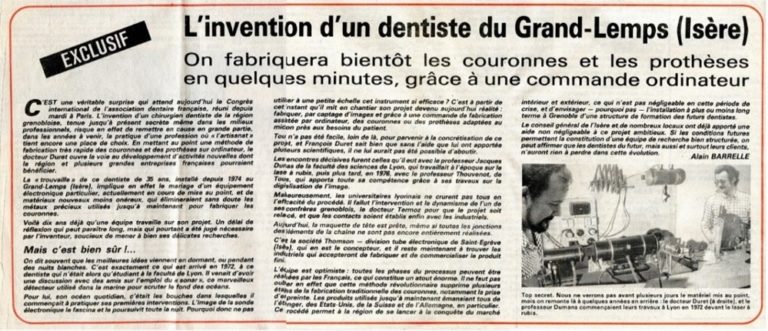
1st press article in the newspaper “Dauphiné Liberated” of November 26, 1982. You see me on the right with Prof J Dumas behind a Ruby laser in 1970 (not 1972 as indicated).
This page presents the two essential aspects of the activity of an «inventor».
You will first find the birth of a new idea that can be the starting point of a long career. In my case it is digital dentistry, or «new dentistry», introduced in my thesis of 1970-1973 and then demonstrated for the first time worldwide and in public in Paris in September 1983.
Then you will have access to the second part, these patents that have staked my life as the milestones of a long way.
- For my patents you have at your disposal:
A 5-page summary of my inventions, and an illustrated chronological listing broken down by discipline of my patents and a personal commentary on my activity as an inventor only for those who would like to know more.
